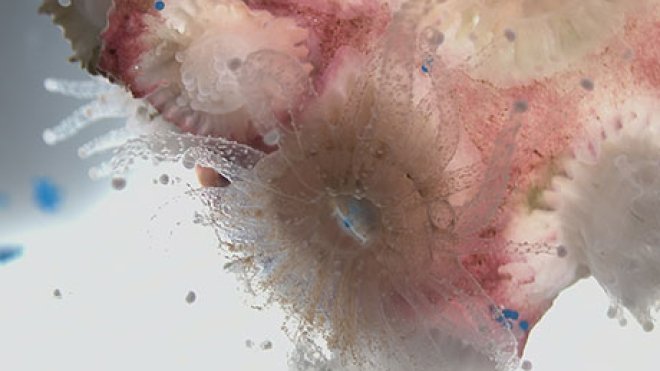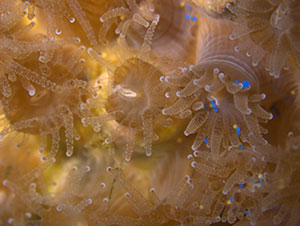Microscopic Plastics Pose a Deadly Threat to Corals
A research team involving a Roger Williams University professor publish a new study finding that corals will choose to eat plastic over their natural food source, which can lead to illness and death from pathogenic microbes attached to the microscopic plastic particles

BRISTOL, R.I. – We’ve heard the news stories of whales washing ashore with bellies filled with plastic. Of sea turtles suffocating from plastic straws clogging their nostrils. Now, a team of researchers including Roger Williams University Professor Koty Sharp have discovered that corals are not only ingesting, and can die from, microscopic particles of plastic, but when given the choice between plastic or food, the corals more often choose plastic.
A report – “Patterns, dynamics and consequences of microplastic ingestion by the temperate coral, Astrangia poculata” – published today in London’s science journal, Proceedings of the Royal Society B: Biological Sciences, was the first of its kind to identify that corals inhabiting the East Coast of the United States are consuming a staggering amount of microplastics, which alters their feeding behavior and has the potential to deliver fatal pathogenic bacteria.
In their samples of the local coral Astrangia poculata, collected off the coast of Jamestown, R.I., each coral polyp – about the size of a pin head – contained more than 100 particles of microplastics, according to the collaborative research team, including RWU Associate Professor of Marine Biology Koty Sharp, and colleagues from Boston University, UMass Boston, Boston Children’s Hospital Division of Gastroenterology, Harvard Medical School, and New England Aquarium.

When the scientists conducted experiments of feeding microbeads to the corals in their labs, Sharp says they found that the coral would more often choose plastic when given the choice between plastic and food of similar sizes and shapes such as shrimp eggs. Exposure to microplastics also resulted in a shift in their feeding behavior. Their study also shows that bacteria can “ride in” on the microbeads. In the case of the bacteria they used in the lab – the intestinal bacterium E. coli – the microplastic-delivered bacteria killed the polyps that ingested them – and their neighboring polyps – within just weeks in the researchers’ experiments.
“Research has shown that there are virtually no marine habitats that are untouched by plastics,” said Sharp, adding that research abounds demonstrating that nearly all seawater contains plastics pollution. “Because of that, it’s critical that we understand the impact of plastics pollution. Microplastics pollution is a matter of global health – ecosystem health and human health.”
But Sharp is quick to note that the problem of plastics pollution extends far beyond what we can see. Plastics never fully degrade in seawater, breaking down into smaller and smaller pieces, according to Sharp. Invisible to the naked eye, microplastics remain suspended in the water column, and this is what corals and other filter-feeding animals take in to get their food. The scientists had anticipated they’d find microplastics in the wild corals, but they were shocked by the volume present in their samples.
Another invisible factor at hand is the presence of microbes that hitch a ride with plastics floating in the ocean – winding up in the stomachs of many creatures – and are growing in number and tipping the balance of ecosystems. The problem is getting worse, thanks to human-induced climate change helping the bacteria to proliferate. In a National Geographic article published yesterday on their research, Sharp noted that microplastics in the ocean are coated with microbes, and the research team wanted to test whether the plastics can “deliver” bacteria – ultimately leading the animals to unintentionally ingest plastics and any microbes on them.
“We know that plastic particles provide an enriching habitat for bacteria that are not usually in very high numbers in seawater. What will be the fate of the animals that ingest those novel microbes? Can those microbes cause disease? Can those microbes be transported through the food web from prey to predator?” Sharp said. “The microbial aspect of microplastics pollution is largely underexplored – it’s critical that we learn more about how plastics can affect the dynamics, abundance, and transport of microbes through our ecosystems and food webs. Alteration of microbiomes in our marine ecosystems by human-induced threats like plastics pollution and climate change holds great potential to impact marine environments on a global scale.”
To help prevent the problem of plastics pollution from getting worse, Sharp offers some tips for everyday action for reducing plastics in our waste stream:
- Recycling plastics is not enough – minimizing single-use plastics is a critical step. Get reusable shopping bags. Buy groceries in bulk. Bring your own cup to the coffee shop. Decline a straw if you don’t need one.
- Take a day to count – how many times in one day do you use single-use plastics. What is unnecessary and what can be eliminated or replaced with more sustainable products?
- As a consumer, demand lower-impact packaging and support products with sustainable packaging.
- Support and advocate for legislation and lawmakers that promote innovative solutions and alternatives for sustainable packaging.
As research like Sharp’s continues to shed a light on the devastating impact of plastics pollution, governments and individuals have already begun taking steps to counteract the issue. Many communities nationally and locally, like Bristol, Barrington and Warren, have enacted bans on single-use plastic bags. A viral movement in the last year – that has been put into practice at RWU – has raised awareness of ditching disposable plastic straws for reusable tools to deliver beverages. The Canadian government is taking an even bigger step with a proposed law to ban all single-use plastics across the country.
With many in the global scientific community taking up the call to mitigate the impact of human-induced threats of climate change and plastics pollution, Sharp emphasized the importance of focusing on both.
“Given that plastics pollution is an ongoing threat co-occurring with climate change, it’s critical that we do more research to understand how they impact marine ecosystems together – and take immediate actions to minimize human impacts on the world’s oceans,” she said.